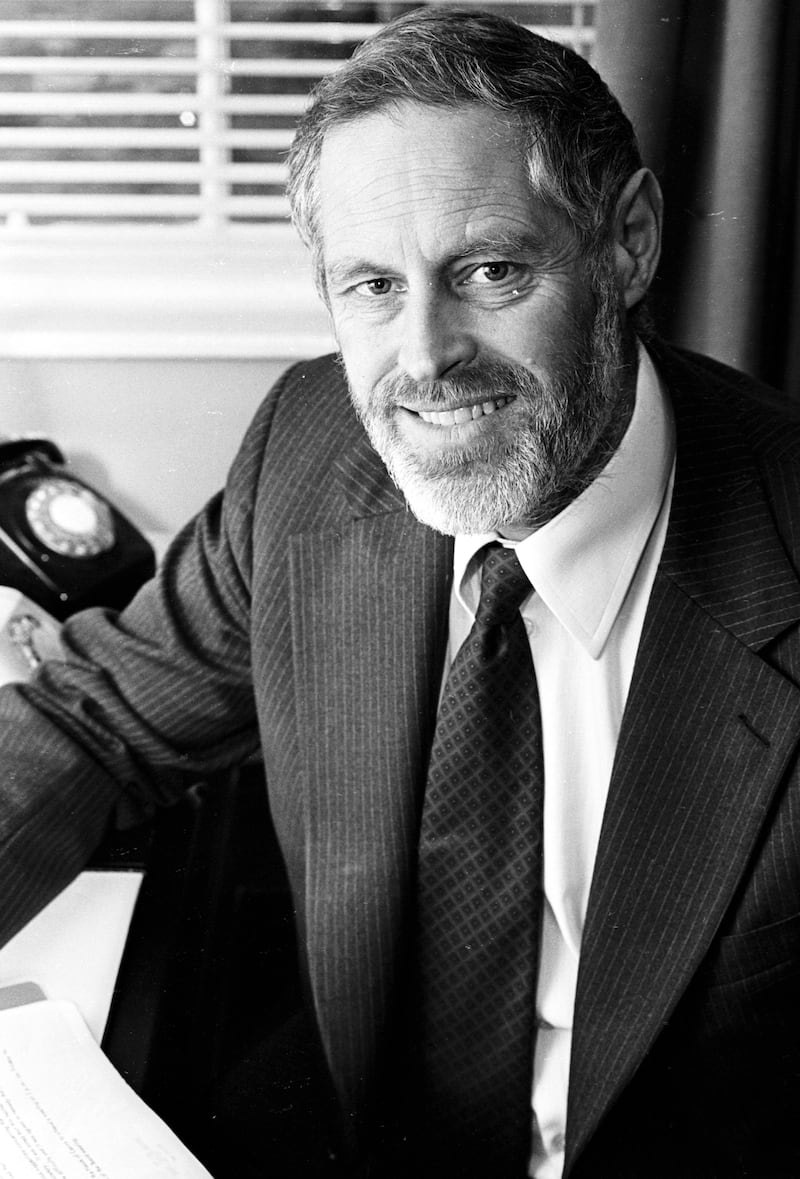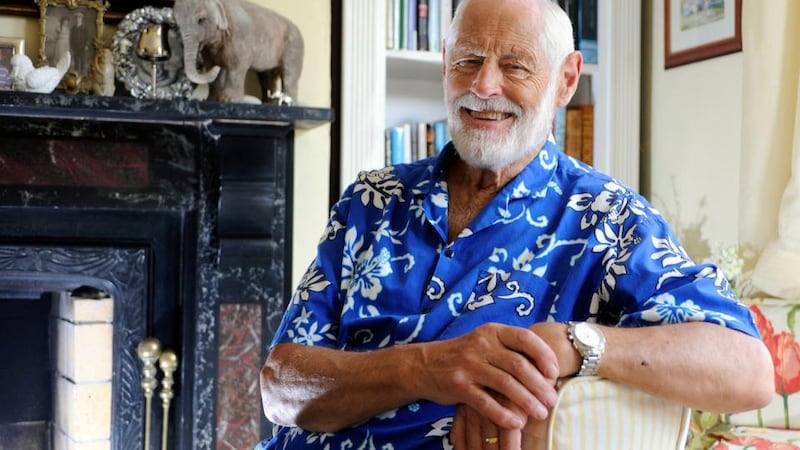Born: March 18th, 1929
Died: January 24th, 2024
He was a big baby, 13lb (5.9kg), and “a mistake”. Born on March 18th, 1929, an unplanned child in a middle-class family living at Dublin’s Sandycove, William Ivory Browne would hear his father say: “I’m afraid Ivor was a mistake. I don’t know if I’ll ever be able to educate him.” Within the family, including siblings Valentine and Ismay, he was seen as “not the full shilling”, he would recall.
Their father James worked at the National Irish Bank on Dublin’s College Green, having served with the British navy during the first World War. His wife Gracie Darling was Protestant. “My mother was Church of Ireland and my father was a sort of rebellious Catholic, so although I was brought up as a Catholic, I didn’t feel part of the dominant culture. It made me think differently and that stayed with me all my life,” Browne would say later.
READ MORE
He attended Blackrock College and developed a lifelong interest in jazz, attracted by its free, improvised style. He played trumpet and intended to be a professional musician. “I only took up medicine to keep my parents off my back . . . I was determined to be a jazz musician.”
[ Ivor Browne: ‘When you give as much love as you can, you get it back 100-fold’Opens in new window ]

That ambition was ended by tuberculosis which meant long periods of isolation in Sandycove during which he developed a profoundly mystical sensibility, initially through reading works by great Catholic saints such as Newman, Aquinas and Augustine. This led in the 1970s to deep involvement with Sahaj Marg, an Indian meditation system that changed his life.
In 1947, on his second attempt, he passed the entrance exam to Dublin’s Royal College of Surgeons. An unremarkable student, he graduated in 1954. Then professor of medicine there, Leonard Abrahamson, advised him “you’re only fit to be an obstetrician or a psychiatrist”. So Browne began an internship at St Brendan’s psychiatric hospital in Dublin’s Grangegorman.
He assisted surgeons in the neurosurgical unit. As he recalled in a 2008 Irish Independent interview: ”Nearly every Saturday morning one or two patients would be sent down from Grangegorman to have their brains ‘chopped’ . . . this was the major lobotomy procedure . . . where burr holes were drilled on each side of the temples and a blunt instrument inserted to sever the frontal lobes almost completely from the rest of the brain.”
[ In praise of Ivor Browne: groundbreaker, lifesaverOpens in new window ]
There were 2,000 patients in Grangegorman then, where wards “had upwards of 100 patients in them”. Few patients were discharged, while mildly disturbed people ended up in chronic wards where they sank into depression and stayed for years, he said.
In July 1956, as a trainee psychiatrist, he spent a year at Warneford Hospital in Oxford learning from Dr Joshua Bierer, a pioneer in social psychiatry. Browne later recalled “an old fellow in Oxford who was some sort of psychoanalyst saying to me, ‘Don’t buy any of the current theories, find your own way.’ That advice has always stayed with me. I don’t feel as if I belong to any school. I think most people find it very hard to live with uncertainty, so they tend to join some ‘ism.”
There followed a fellowship in public and community mental health at Harvard University in the US, before he came back to Dublin and worked in St John of God’s. “Major tranquillisers, psychoactive and anti-psychotic drugs were just being introduced at that time. Young boys were coming up from the country diagnosed with schizophrenia, and the drugs seemed to bring them back to normal . . . but by my second year nearly all of them were coming back in a worse state than before, and that raised a big question in my mind about orthodox psychiatry: that while it was removing symptoms, it wasn’t really changing people.”

In April 2017 Browne told the magazine Network that in the psychiatric model, “you cannot ask how the behaviour or upbringing of a person is affecting their biochemistry – you can only ask how is the biochemistry affecting the person”, he said.
In psychotherapy, he said, “you are giving the person a safety net in which they feel comfortable enough to open up the trauma; in psychiatry you are given a diagnosis”.
He believed that experience passes through the limbic system, a primitive part of the brain. Experience that is “very threatening or traumatic when it hits that area of the brain, it fires the body”. Then “what we feel can be so great that the message comes back saying ‘shut down, I cannot handle this’”.
Once this happens, “that experience is frozen”. It is “outside of time, so 20 years later this can be activated – some everyday event can trigger it – and you then experience it as if it is happening now. That is why I called it ‘the frozen present’.”
However, he was not against drugs. Some drugs were “a real help. A lot depends on how you use them. We wouldn’t be able to start to work with quite a number of psychotic people without some initial help,” he said. As a young man he had himself experimented with LSD, and he used ketamine in some therapy sessions.
Included among people he helped over the years were artists, as well as abuse survivors, some of whom insist he saved their lives.
From 1965 to the mid-1995, he was chief psychiatrist with the then Eastern Health Board and became professor of psychiatry at University College Dublin. Over those decades he led a revolution that saw a dismantling of institutions in Ireland such as St Brendan’s, Grangegorman, and the development of community clinics.
At the funeral service on Monday, professor of psychiatry at Trinity College Dublin, Brendan Kelly, described this as the reversal of “Ireland’s fatal weakness for institutional solutions to social problems”. Browne’s most profound legacy was “the additional liberty enjoyed by thousands of people who avoided institutionalisation as a result of the reforms which Ivor came to represent”.
Browne also founded the Irish Foundation for Human Development, as well as developing linked community models in Ballyfermot and Derry city.
In the early 1960s, at St Loman’s Hospital in Dublin, one of his patients was the late Phyllis Hamilton, a victim of child sexual abuse by her father. Later, with Fr Michael Cleary, she had two sons, one of whom was given up for adoption. In 1993, after Fr Cleary – also a patient of Browne’s – died, the existence of his sons was reported in media but denied by the Catholic Church and members of the priest’s family. Authorised by Hamilton, Browne confirmed her story publicly. DNA evidence also stood up what she said. In 1996 the Medical Council censured Browne for alleged breach of confidentiality and ethical standards, but ruled he acted for the patient. The decision to censure him astonished many. “I still believe that my ethical duty was to do what I could to protect my patient. If the same circumstances arose again, I would do the same thing,” he said.
It was his love of music, in this case Irish traditional music, that brought him to his late wife Orla Kiernan, daughter of folk singer Delia Murphy. They had four children together.
He was subsequently married for 35 years to June Levine, who died in 2008.
Browne was, as President Michael D Higgins said: “A visionary and radical psychiatrist who left a profound mark on the understanding and attitudes to mental illness in Ireland.”
He is survived by his large blended family, which includes seven children – Ronan, Garvan, Daragh and Tierna and stepchildren Diane, Mike and Adam – 10 grandchildren, two great grandchildren, and an extended family including in-laws, nephews and nieces. He was predeceased by June, his siblings, Valentine and Ismay, and his first wife, Orla.













